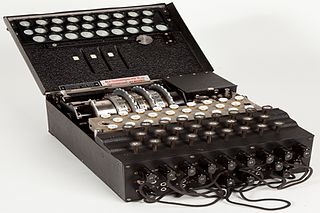
The Enigma machine is a cipher device developed and used in the early- to mid-20th century to protect commercial, diplomatic, and military communication. It was employed extensively by Nazi Germany during World War II, in all branches of the German military. The Enigma machine was considered so secure that it was used to encipher the most top-secret messages.

In the history of cryptography, Typex machines were British cipher machines used from 1937. It was an adaptation of the commercial German Enigma with a number of enhancements that greatly increased its security. The cipher machine was used until the mid-1950s when other more modern military encryption systems came into use.

In cryptanalysis, frequency analysis is the study of the frequency of letters or groups of letters in a ciphertext. The method is used as an aid to breaking classical ciphers.
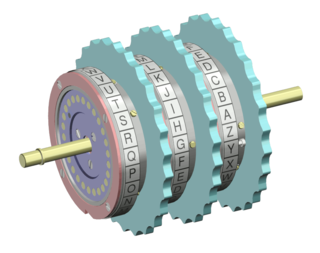
In cryptography, a rotor machine is an electro-mechanical stream cipher device used for encrypting and decrypting messages. Rotor machines were the cryptographic state-of-the-art for much of the 20th century; they were in widespread use in the 1920s–1970s. The most famous example is the German Enigma machine, the output of which was deciphered by the Allies during World War II, producing intelligence code-named Ultra.

Fish was the UK's GC&CS Bletchley Park codename for any of several German teleprinter stream ciphers used during World War II. Enciphered teleprinter traffic was used between German High Command and Army Group commanders in the field, so its intelligence value (Ultra) was of the highest strategic value to the Allies. This traffic normally passed over landlines, but as German forces extended their geographic reach beyond western Europe, they had to resort to wireless transmission.
Cryptologia is a journal in cryptography published six times per year since January 1977. Its remit is all aspects of cryptography, with a special emphasis on historical aspects of the subject. The founding editors were Brian J. Winkel, David Kahn, Louis Kruh, Cipher A. Deavours and Greg Mellen. The current Editor-in-Chief is Craig Bauer.
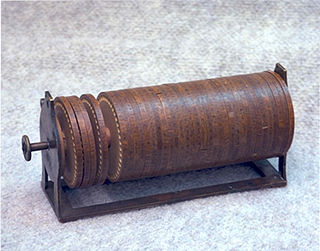
The Jefferson disk, also called the Bazeries cylinder or wheel cypher, was a cipher system commonly attributed to Thomas Jefferson that uses a set of wheels or disks, each with letters of the alphabet arranged around their edge in an order, which is different for each disk and is usually ordered randomly.

In the history of cryptography, M-325, also known as SIGFOY, was an American rotor machine designed by William F. Friedman and built in 1944. Between 1944 and 1946, more than 1,100 machines were deployed within the United States Foreign Service. Its use was discontinued in 1946 because of faults in operation. Friedman applied for a patent on the M-325 on 11 August 1944; it was and was granted on 17 March 1959.

In the history of cryptography, the Kryha machine was a device for encryption and decryption, appearing in the early 1920s and used until the 1950s. The machine was the invention of Alexander von Kryha. During the Second World War, Kryha worked as an officer for the German Wehrmacht. There were several versions; the standard Kryha machine weighed around five kilograms, and was totally mechanical. A scaled down pocket version was introduced later on, termed the "Lilliput" model. There was also a more bulky electrical version.

JADE was the codename given by US codebreakers to a Japanese World War II cipher machine. The Imperial Japanese Navy used the machine for communications from late 1942 until 1944. JADE was similar to another cipher machine, CORAL, with the main difference that JADE was used to encipher messages in katakana using an alphabet of 50 symbols.
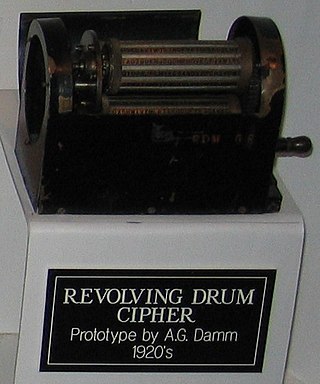
Arvid Gerhard Damm was a Swedish engineer and inventor. He designed a number of cipher machines, and was one of the early inventors of the wired rotor principle for machine encipherment. The company, AB Cryptograph, was an early predecessor of Crypto AG.
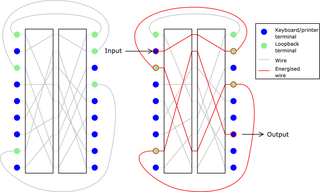
The HX-63 was an advanced rotor machine designed by Crypto AG founder Boris Hagelin. Development of the device started in 1952 and lasted a decade. The machine had nine rotors, each with 41 contacts. There were 26 keyboard inputs and outputs, leaving 15 wires to "loop back" through the rotors via a different path. Moreover, each rotor wire could be selected from one of two paths. The movement of the rotors was irregular and controlled by switches. There were two plugboards with the machine; one to scramble the input, and one for the loop-back wires. The machine also used a technique called reinjection (also called reentry), which increased its security exponentially. The machine could be set up in around 10600 different configurations.

The (Hagelin) CD-57 was a portable, mechanical cipher machine manufactured by Crypto AG, first produced in 1957. It was derived from the earlier CD-55, and was designed to be compatible with the larger C-52 machines. Compact, the CD-57 measured merely 5 1/8in × 3 1/8in × 1 1/2in and weighed 1.5 pounds. The CD-57 used six wheels.

The (Hagelin) C-52 and CX-52 were cipher machines manufactured by Crypto AG starting 1951/1952. These pin-and-lug type cipher machines were advanced successors of the C-38/M-209. The machine measures 8+1⁄2 by 5+3⁄8 by 4+3⁄8 inches. The device is mechanical, but when combined with an electric keyboard attachment, the B-52, the resultant system is termed the BC-52. The B-52 is larger, measuring 12+1⁄2 by 8+1⁄2 by 6+3⁄8 inches.

The C-35 and C-36 were cipher machines designed by Swedish cryptographer Boris Hagelin in the 1930s. These were the first of Hagelin's cipher machines to feature the pin-and-lug mechanism. A later machine in the same series, the C-38, was designated CSP-1500 by the United States Navy and M-209 by the United States military, who used it extensively.
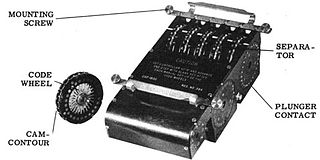
The Combined Cipher Machine (CCM) was a common cipher machine system for securing Allied communications during World War II and, for a few years after, by NATO. The British Typex machine and the US ECM Mark II were both modified so that they were interoperable.

Rockex, or Telekrypton, was an offline one-time tape Vernam cipher machine known to have been used by Britain and Canada from 1943. It was developed by Canadian electrical engineer Benjamin deForest Bayly, working during the war for British Security Coordination.

The OMI cryptograph was a rotor cipher machine produced and sold by Italian firm Ottico Meccanica Italiana (OMI) in Rome.

Marian Adam Rejewski was a Polish mathematician and cryptologist who in late 1932 reconstructed the sight-unseen German military Enigma cipher machine, aided by limited documents obtained by French military intelligence.
The Chaocipher is a cipher method invented by John Francis Byrne in 1918 and described in his 1953 autobiographical Silent Years. He believed Chaocipher was simple, yet unbreakable. Byrne stated that the machine he used to encipher his messages could be fitted into a cigar box. He offered cash rewards for anyone who could solve it.


















